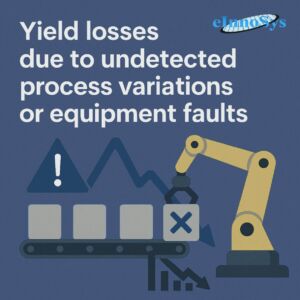In today’s highly competitive semiconductor industry, yield losses due to undetected process variations or equipment faults represent a significant barrier to profitability. Even small deviations in process control or equipment behavior can cause defects that lead to costly rework, wasted materials, and delivery delays. As devices shrink and complexity increases, the industry requires more sophisticated solutions for semiconductor yield loss, process variation detection, and equipment fault detection to maintain efficiency and ensure quality.
A critical enabler of this effort is SECS/GEM, a global communication standard that allows equipment to interact seamlessly with host systems. With the help of tools such as a SECS GEM SDK, manufacturers can integrate data collection and control across their fabs, creating the foundation for smarter monitoring and yield improvement in semiconductor manufacturing.

The Hidden Cost of Undetected Process Variations
Process variations are inevitable in high-volume manufacturing, but undetected variations can spiral into major yield management problems. For example, a slight shift in temperature, gas flow, or pressure within a piece of process equipment may go unnoticed during production runs. These changes may not immediately stop the line but can accumulate defects that reduce output quality.
When fabs fail to implement effective process variation detection, the result is higher scrap rates, lower yields, and increased production costs. This is why advanced semiconductor defect analysis and automated data collection have become essential. Leveraging SECS/GEM connectivity, fabs can continuously monitor process parameters, ensuring anomalies are detected before they impact a large batch of wafers.
The Role of Equipment Fault Detection
Equipment reliability directly affects yield. Minor malfunctions such as sensor drift, calibration errors, or wear in mechanical parts often remain hidden until they result in major downtime or scrap. Implementing real-time equipment fault detection allows manufacturers to identify and resolve these issues proactively.
Using a SECS GEM SDK, engineers can build host applications that track tool health, collect diagnostic information, and trigger alerts when parameters deviate from expected ranges. This integration not only minimizes undetected process variations but also reduces unplanned downtime. As a result, fabs achieve better yield management solutions and extend the life of their equipment assets.
Data-Driven Yield Management Solutions
Modern fabs cannot rely solely on manual inspections or post-process testing to catch issues. Instead, they are adopting manufacturing yield optimization strategies that rely on continuous monitoring, AI-driven analytics, and automated control.
A key part of this approach is semiconductor defect analysis, where large volumes of data are used to identify defect sources and patterns. With SECS/GEM standards in place, equipment across the fab can feed real-time data into central systems, enabling predictive analytics for yield improvement in semiconductor manufacturing.
By combining process variation detection with equipment fault detection, fabs gain a holistic view of production health. This shift from reactive to proactive operations translates into reduced semiconductor yield loss, faster root cause analysis, and more consistent product quality.
Building Smart Fabs with SECS GEM SDK
To achieve these benefits, manufacturers need tools that simplify SECS/GEM integration. A SECS GEM SDK provides developers with libraries and APIs that make it easier to implement communication between equipment and factory systems. Instead of building protocols from scratch, fabs can quickly enable equipment monitoring, control commands, and data collection.
Such integration accelerates the deployment of yield management solutions and ensures compliance with SEMI standards. Moreover, it empowers engineers to build custom applications for manufacturing yield optimization, aligning with the growing trend of Industry 4.0 and smart factories.
Yield losses due to undetected process variations or equipment faults are among the most persistent challenges in the semiconductor industry. Addressing these issues requires robust process variation detection, proactive equipment fault detection, and advanced semiconductor defect analysis. By leveraging SECS/GEM connectivity and tools like a SECS GEM SDK, manufacturers can build reliable yield management solutions that reduce semiconductor yield loss and drive yield improvement in semiconductor manufacturing.
Ultimately, smart data collection and communication are the keys to manufacturing yield optimization. As fabs continue to modernize, investing in SECS/GEM integration will remain central to ensuring high quality, consistent output, and long-term competitiveness in the semiconductor marketplace.

